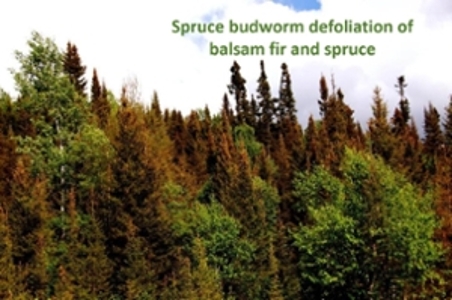Spruce budworm tree host species distribution and abundance mapping using multi-temporal Sentinel-1 and Sentinel-2 satellite imagery
Author: Bhattarai R., Rahimzadeh-Bajgiran P., Weiskittel A., Meneghini A., MacLean D.A.
Posted on Mar 26, 2021
Category: Publications , Research
Abstract: Spruce budworm (Choristoneura fumiferana; SBW) is the most destructive forest pest of northeastern Canada and United States. SBW occurrence as well as the extent and severity of its damage are highly dependent on the characteristics of the forests and the availability of host species namely, spruce (Picea sp.) and balsam fir (Abies balsamea (L.) Mill.). Remote sensing satellite imagery represents a valuable data source for seamless regional-scale mapping of forest composition. This study developed and evaluated new models to map the distribution and abundance of SBW host species at 20 m spatial resolution using Sentinel-1 synthetic aperture radar (SAR) and Sentinel-2 multispectral imagery in combination with several site variables for a total of 191 variables in northern New Brunswick, Canada using the Random Forest (RF) algorithm. We found Sentinel-2 multi-temporal single spectral bands and numerous spectral vegetation indices (SVIs) yielded the classification of SBW host species with an overall accuracy (OA) of 72.6% and kappa coefficient (K) of 0.65. Incorporating Sentinel-1 SAR data with Sentinel-2 variables coupled with elevation, only marginally improved the performance of the model (OA: 73.0% and K: 0.66). The use of Sentinel-1 SAR data with elevation resulted in a reasonable OA of 57.5% and K of 0.47. These spatially explicit up-to-date SBW host species maps are essential for identifying susceptible forests, monitoring SBW defoliation, and minimizing forest losses from insect impacts at landscape scale in the current SBW outbreak in the region.
Authors: Bhattarai R.a, Rahimzadeh-Bajgiran P.a, Weiskittel A.a, Meneghini A.a, MacLean D.A.b
Affiliations:
aSchool of Forest Resources, College of Natural Sciences, Forestry, and Agriculture, University of Maine, Orono, ME 04469, USAbFaculty of Forestry and Environmental Management, University of New Brunswick, P.O. Box 4400, Fredericton, NB E3B 5A3, Canada

